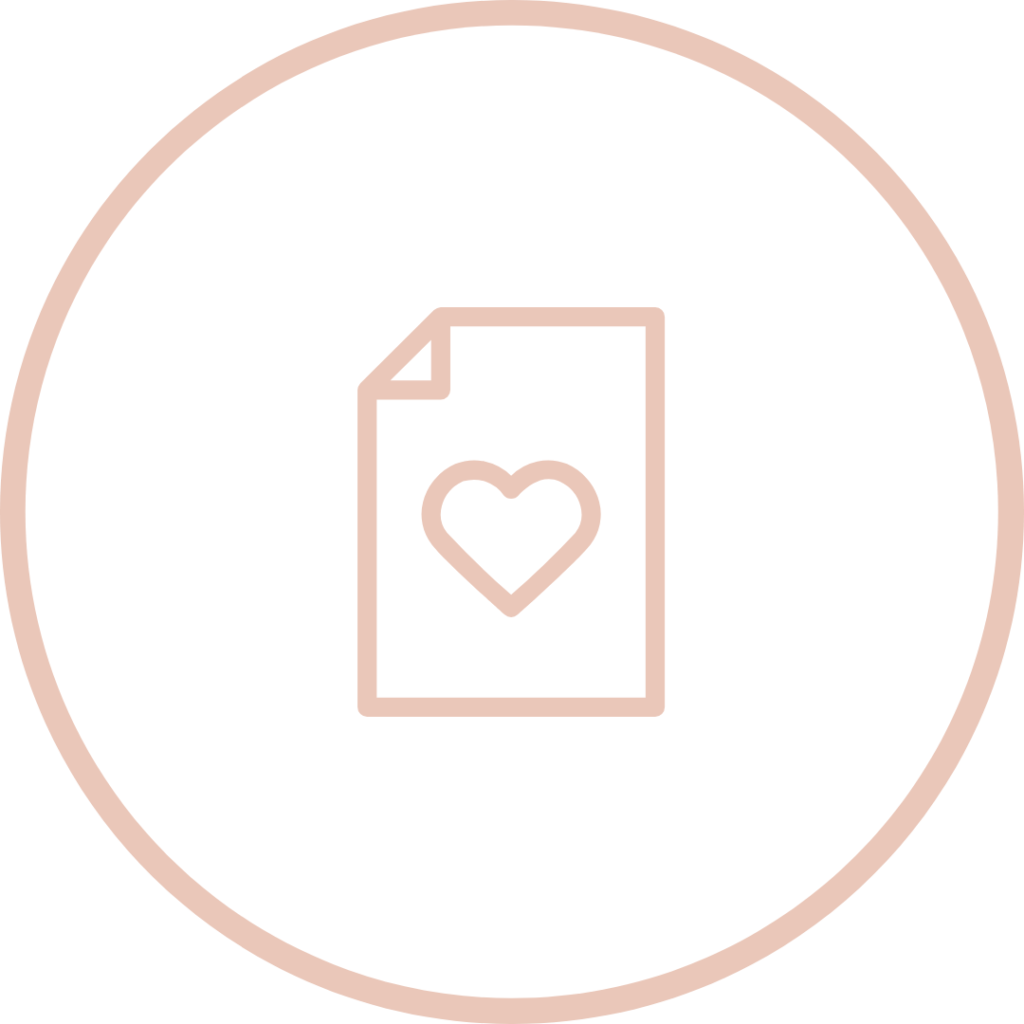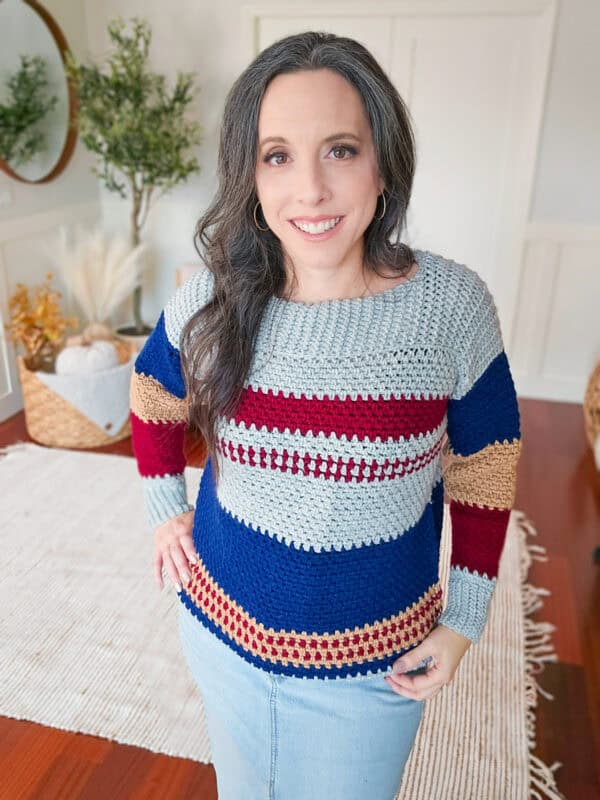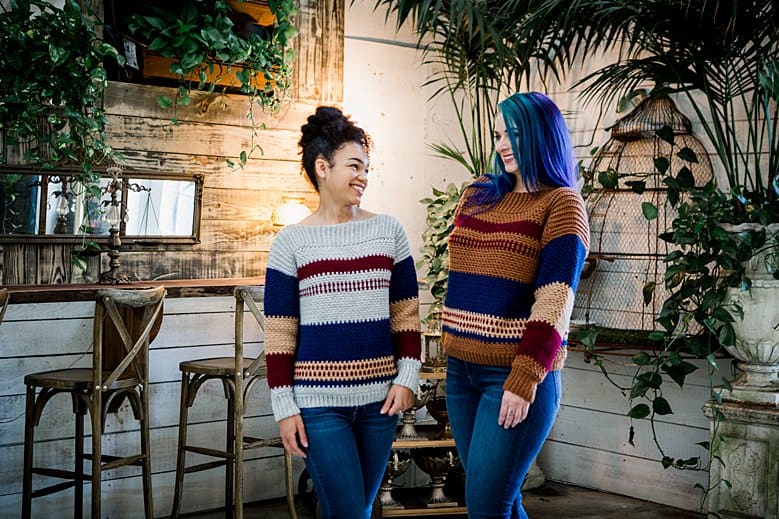Gingersnap Crochet Pullover Sweater Pattern
A soft and cozy pullover in the season’s trendiest colors. Create your own color combination or follow along with our winter palette. The Gingersnap Pullover Sweater has a knit-look ribbed neck with a moss stitch patterned stitch for the body.
The moss stitch holds a special place in my list of favorite crochet techniques, thanks to its exceptional versatility and texture. It creates a beautiful drape that flows effortlessly, making it ideal for garments and accessories that need a bit of movement.
What sets the moss stitch apart is its unique appearance, which mimics the look of knitted fabric, giving your crochet projects a sophisticated, knit-like finish.
The moss stitch pattern is easy to master with a simple, repetitive sequence, making it perfect for beginners and experienced crocheters alike. Since it’s a quick stitch to work up, it allows you to complete projects faster but still getting a great style.
If you love this stitch, you might also like the Shortbread Crochet Duster. And if you love knit-look stitches the Amazing Juniper Knit-Look Crochet Hat Pattern or the Crochet One Piece Mittens Free Pattern are quick and fun projects.
Gingersnap Crochet Pullover Sweater Supplies
Crochet Hook:
5.5 mm (I), Crochet Hook
Notions:
Yarn Needle
Scissors
Yarn:
WeCrochet Brava (weight 4 worsted, 100% Premium Acrylic, 218 yds/199 m, 100 g)
In Colorways:
Brindle (Color A): 2 (2, 3, 3, 3) (4, 4, 4, 4) balls or 400 (425, 475, 525, 575) (650, 750, 850,
950) yards
Wine (Color B): 1 (1, 1, 1, 1) (2, 2, 2, 2) balls or 100 (125, 150, 175, 200) (225, 275, 350, 400)
yards
Solstice Heather (Color C): 1 (2, 2, 2, 2) (2, 2, 3, 3) balls or 200 (225, 250, 275, 300) (350,
400, 450, 500) yards
Almond (Color D): 1 (1, 1, 1, 1) (2, 2, 2, 2) balls or 100 (125, 150, 175, 200) (225, 275, 350,
400) yards
Gauge:
13 sts by 8.5 rows = 4” square
see gauge notes in the pattern
Measurements/Sizes:
XS (S, M, L, 1X) (2X, 3X, 4X, 5X)
Schematic in the pattern.
Skill Level:
Easy/Advanced Beginner
Notes:
A video instruction for size small can be found on YouTube.
The Gingersnap Pullover starts with working the neckline section, then building the body of the sweater on each side of the neckline section. The sleeves are crocheted on each side of the piece and then the pullover is seamed.
When a stitch is written in front of the abbreviation such as Xdc- this means the X number of stitches will all be in one stitch or space. When the stitch is written after the abbreviation such as dc X – this means stitches will each be worked across X amount of stitches.
For straighter edges, ch 1 at the beginning of each row can be omitted.
The sc2tog for this pattern will be worked over a single crochet stitch and a slip stitch.
Subscribe & Like
Gingersnap Sweater Video Tutorial:
Relax & Crochet
Upgrade to the Printable PDF
Beautifully formatted to print and relax while crocheting. The paid pattern includes:
Purchase the PDF Pattern on Etsy or Ravelry.

Click the box below to unlock this exclusive subscriber content for free. Add your email and create a password. If you are having trouble, reset your password or login to the Grow Portal.
I’m thrilled to share this amazing crochet pattern with you! Please don’t copy, paste, or distribute this pattern. Prefer an ad-free experience? Purchase a digital PDF file for a small fee from one of my online stores. I appreciate your support and readership. You are why I can keep doing what I love and sharing it with others. Thank you from the bottom of my heart.
Gingersnap Pullover Written Crochet Instructions
Neckline Sections
Shoulder First Section
Set-Up Row (ws): With Color A, ch 27 for all sizes, sl st in the second chain from hook and in each stitch across, turn. 26 sts for all sizes.
Row 1 (rs): Ch 1, in blo sl st in each sts across, turn.
Row 2: Ch 1, in flo sl st in each sts across, turn. Repeats: Repeat rows 2-3 for 14 (18, 20, 26, 28) (32, 36, 38, 42) more rows.
Neck Opening First Section
Row 1: Ch 1, in blo sl st 13 (leave the rest of the sts unworked), turn. 13 sts for all sizes Row 2: Ch 1, in flo sl st 13, turn. Repeats: Repeat rows 1-2 for 38 (38, 40, 40, 42) (42, 42, 44, 44) more rows, fasten off.
Neck Opening Second Section Row 1: Attach yarn to the unworked row to the left of the neck opening first section. We aren’t skipping any stitches but working right next to the First Neck Section. Ch 1, in blo sl st 13 (leave the rest of the sts unworked), turn.
Row 2: Ch 1, in flo sl st 13, turn. Repeats: Repeat rows 1-2 for 38 (38, 40, 40, 42) (42, 42, 44, 44) more rows, fasten off.
Shoulder Second Section
Row 1: Now we will work across both the Neck Opening First Section and Second Section. With RS facing, attach yarn to the right edge of your work. Ch 1, in blo sl st in each sts across, turn. 26 sts for all sizes
Row 2: Ch 1, in flo sl st in each sts across, turn.
Repeats: Repeat rows 2-3 for 14 (18, 20, 26, 28) (32, 36, 38, 42) more rows. Fasten off and weave in any ends.

Body Sections
Set-Up Row (rs): With Color A, attach yarn to the corner of the long edge of the neckline section. Ch 1, sl st 70 (78, 84, 96, 102) (110, 118, 124, 132), turn.
Row 1 (ws): Ch 1, flo sc in first, *ch 1, skip 1, flo sc in next*; repeat from * to * across until last st, flo sc in last, turn. 70 (78, 84, 96, 102) (110, 118, 124, 132) sts
Row 2: Ch 1, sc in first *ch 1, skip 1, sc in next*; repeat from * to * across until last st, sc in last, turn.
Color Changes for Repeats
Continue to work in the established moss stitch pattern, repeating Row 2 while changing colors on indicated rows as follows:
Row 4 – 7: Color A
Row 8 – 13: Color B
Row 14 – 17: Color A
Row 18: Color B
Row 19: Color A
Row 20: Color B
Row 21 – 33: Color A
Row 34 – 50: Color C
Row 51 – 52: Color D
Row 53: Color B
Row 54 – 55: Color D
Row 56: Color B
Row 57 – 58: Color D
Row 59 – 61: Color C
Row 62 – 65: Color A
Repeat this section for the opposite side body panel.
Sleeves
On the body sections, place a stitch marker on each side of the body or rows 13 (15, 17, 19, 21) (22, 24, 26, 28). This will mark the area where the sleeves will be worked along the side of the body.
Rotate your work with the right side facing to begin working the sleeve along the sides of the shoulder and body.
Sleeves Sizes X-Small (Small)
Set-Up Row (rs): With Color C, attach yarn at one of the stitch markers, ch 1, work 54 (58) sl sts between the markers. 54 (58) sts
Row 1 (ws): Ch 1, flo sc in first, *ch 1, skip 1, flo sc in next*; repeat from * to * across until last st, sc in last, turn.
Row 2: Ch 1, sc in first *ch 1, skip 1, sc in next*; repeat from * to * across until last st, sc in last, turn.
Row 3: Repeat Row 2.
Row 4: Ch 1, sc2tog, sc in next, *ch 1, skip 1, sc in next*; repeat from * to * across until last 3 sts, ch 1, skip 1, sc2tog, turn. 52 (56) sts
Row 5-7: Ch 1, sc in first 2 sts, *ch 1, skip 1, sc in next*; repeat from * to * across, turn.
Row 8: Ch 1, sc2tog, *ch 1, skip 1, sc in next*; repeat from * to * until the last 2 sts, sc2tog, turn. 50 (54) sts
Row 9-11: Repeat Row 2.
Repeat Rows 4-11 (while also following the color changes below) until the sts count is 30 (32). Then work in established moss stitch until the total row count is 54 for either size.
Then repeat for the sleeve on the other side.
Row 1 – 17: Color C
Row 18 – 34: Color D
Row 35 – 51: Color B
Row 52 – 54: Color A
Sleeves Sizes Medium (Large, 1X, 2X, 3X, 4X)
Set-Up Row (rs): With Color C, attach yarn at one of the stitch markers, ch 1, work 62 (66, 70, 72, 76, 80) sl sts between the markers. 62 (66, 70, 72, 76, 80) sts
Row 1 (ws): Ch 1, flo sc in first, *ch 1, skip 1, flo sc in next*; repeat from * to * across until last st, flo sc in last, turn. 62 (66, 70, 72, 76, 80)
Row 2: Ch 1, sc in first *ch 1, skip 1, sc in next*; repeat from * to * across until last st, sc in last, turn.
Row 3: Ch 1, sc2tog, sc in next, *ch 1, skip 1, sc in next*; repeat from * to * across until last 3 sts, ch 1, skip 1, sc2tog, turn. 60 (64, 68, 70, 74, 78) sts
Row 4-5: Ch 1, sc in first 2 sts, *ch 1, skip 1, sc in next*; repeat from * to * across, turn. 60 (64, 68, 70, 74, 78) sts
Row 6: Ch 1, sc2tog, *ch 1, skip 1, sc in next*; repeat from * to * until the last 2 sts, sc2tog, turn. 58 (62, 66, 68, 72, 76) sts
Row 7-8: Repeat Row 2.
Repeat Rows 3 -8 (while also following the color changes below) until the st count is 34 (36, 38, 40, 40, 42). Then work in the established moss stitch until the total row count is 56 (56, 56, 56, 60, 60).
Then repeat for the sleeve on the other side.
Row 1 – 17: Color C
Row 18 – 34: Color D
Row 35 – 51: Color B
Row 52 – 54: Color A
Sleeves Size 5X
Set-Up Row (rs): With Color C, attach yarn at one of the stitch markers, ch 1, work 84 sl sts between the markers. 84 sts
Row 1 (ws): Ch 1, flo sc in first, *ch 1, skip 1, flo sc in next*; repeat from * to * across until last st, flo sc in last, turn. 84 sts
Row 2: Ch 1, sc2tog, sc in next, *ch 1, skip 1, sc in next*; repeat from * to * across until last 3 sts, ch 1, skip 1, sc2tog, turn. 82 sts
Row 3: Ch 1, sc in first 2 sts, *ch 1, skip 1, sc in next*; repeat from * to * across, turn.
Row 4: Ch 1, sc2tog, *ch 1, skip 1, sc in next*; repeat from * to * until the last 2 sts, sc2tog, turn. 80 sts
Row 5: Ch 1, sc in first *ch 1, skip 1, sc in next*; repeat from * to * across until last st, sc in last, turn.
Repeat Rows 2 -5 (while also following the color changes below) until the st count is 42. Then work in established moss stitch until the total row count is 60.
Then repeat for the sleeve on the other side.
Row 1 – 17: Color C
Row 18 – 34: Color D
Row 35 – 51: Color B
Row 52 – 60: Color A

Seaming
Using a tapestry needle, start at the cuff and seam the sleeve to the underarm and then down the sides. Use any tail ends to seam and then weave in. Repeat on other side.
Sleeves Cuff Ribbing
Set-Up Row: Attach Color A to the bottom of the sleeve at the seam.
Row 1: Ch 13, working in the blo slip stitch in the second chain from hook and across, slip stitch two stitches on the sleeve bottom edge, turn. 12 sts for all sizes
Row 2: Skip the 2 sleeve bottom edge slip sts, in blo sl st 12, turn.
Row 3: Ch 1, in blo sl st 12, sl st into the next two stitches from sleeve bottom edge, turn. Repeat rows 2-3 ribbing around the sleeve’s bottom edge. To join them together either fasten off and seam the beginning edge to the ending edge with a tapestry needle. Or slip stitch through the blo from the ending edge and the stitch from the beginning edge at the same time. Repeat for the other arm.
Bottom Ribbing
Set-Up Row: Attach Color A to the bottom of the sweater at the seam.
Row 1: Ch 8, slip stitch in the second chain from hook and across, slip stitch two stitches on the body bottom edge, turn. 7 sts for all sizes
Row 2: Skip the 2 bottom edge slip sts, in blo sl st 7, turn.
Row 3: Ch 1, in blo sl st 7, sl st into the next two stitches from bottom edge, turn.
Repeat rows 2-3 ribbing around the sweater’s bottom edge.
To join the two edges together either fasten off and seam the beginning edge to the ending edge with a tapestry needle. Or slip stitch through the blo from the ending edge and the stitch from the beginning edge at the same time.
Finishing
Fasten off and weave in ends. Block pullover and wear!
To wrap up (pun intended lol), the Gingersnap Crochet Pullover Sweater is not only a cozy addition to your wardrobe but also a beautiful handmade piece you’ll want to enjoy for seasons to come.
To keep your sweater looking its best, here are a few tips for caring and storing your crochet garment:
- Washing: Always follow the yarn’s care instructions. Hand washing with cold water and a gentle detergent is the safest option for most crochet garments. Avoid wringing out the sweater; instead, gently squeeze out excess water and lay it flat on a towel to dry.
2. Blocking: If the sweater loses its shape over time, lightly steam block it to restore its original form. Place a damp cloth over the sweater and use a steam iron at a safe distance to reshape it.
3. Storage: To prevent stretching, store your crochet pullover folded rather than hanging. Keep it in a cool, dry place, and consider using breathable fabric storage bags to protect it from dust and pests. Avoid storing in plastic bags, which can trap moisture and lead to mildew.
By following these care tips, your Gingersnap Crochet Pullover Sweater will remain a cherished, warm addition to your handmade collection for years to come.
Well That Was Fun! What’s Next?
📌 PIN THIS POST – Don’t lose this project; save it to your Pinterest crochet board so you can quickly come back to it again.
💌 SHARE – Share your yarn choice, in-progress, or finished projects on Facebook or Instagram and use the hashtag #brianakdesigns
🥂 JOIN – Join the kindest crafters in the Briana K Designs Community Group on Facebook. We love yarny friends!
🔗 RAVELRY LINK -Link and share your project on Ravelry. Having inspirational photos can help crafters.
